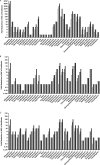Potentiation of Antibiotic Activity by a Novel Cationic Peptide: Potency and Spectrum of Activity of SPR741
- PMID: 28533232
- PMCID: PMC5527571
- DOI: 10.1128/AAC.00200-17
Potentiation of Antibiotic Activity by a Novel Cationic Peptide: Potency and Spectrum of Activity of SPR741
Abstract
Novel approaches for the treatment of multidrug-resistant Gram-negative bacterial infections are urgently required. One approach is to potentiate the efficacy of existing antibiotics whose spectrum of activity is limited by the permeability barrier presented by the Gram-negative outer membrane. Cationic peptides derived from polymyxin B have been used to permeabilize the outer membrane, granting antibiotics that would otherwise be excluded access to their targets. We assessed the in vitro efficacies of combinations of SPR741 with conventional antibiotics against Escherichia coli, Klebsiella pneumoniae, and Acinetobacter baumannii Of 35 antibiotics tested, the MICs of 8 of them were reduced 32- to 8,000-fold against E. coli and K. pneumoniae in the presence of SPR741. The eight antibiotics, azithromycin, clarithromycin, erythromycin, fusidic acid, mupirocin, retapamulin, rifampin, and telithromycin, had diverse targets and mechanisms of action. Against A. baumannii, similar potentiation was achieved with clarithromycin, erythromycin, fusidic acid, retapamulin, and rifampin. Susceptibility testing of the most effective antibiotic-SPR741 combinations was extended to 25 additional multidrug-resistant or clinical isolates of E. coli and K. pneumoniae and 17 additional A. baumannii isolates in order to rank the potentiated antibiotics. SPR741 was also able to potentiate antibiotics that are substrates of the AcrAB-TolC efflux pump in E. coli, effectively circumventing the contribution of this pump to intrinsic antibiotic resistance. These studies support the further development of SPR741 in combination with conventional antibiotics for the treatment of Gram-negative bacterial infections.
Keywords: Gram-negative bacteria; microbiology; potentiation.
Copyright © 2017 American Society for Microbiology.
Figures


References
MeSH terms
Substances
LinkOut - more resources
Full Text Sources
Other Literature Sources
Medical
Molecular Biology Databases

